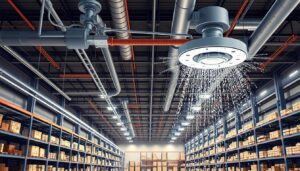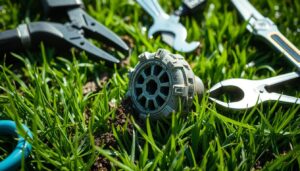Imagine your lawn as a vibrant, green oasis – an inviting space where you can relax and enjoy the beauty of nature. To achieve this picturesque landscape, proper lawn maintenance is essential. One crucial aspect of maintaining a healthy lawn is aerating it.
However, if you have sprinkler heads installed in your yard, you may be concerned about potential damage caused by a lawn aerator.
Fear not! With the right precautions and knowledge, you can safely aerate your lawn without harming your sprinkler heads. In this article, we will delve into how lawn aerators work and provide expert tips on protecting your sprinkler system during the process.
We’ll discuss choosing the appropriate type of aerator for your needs and explore alternative methods to safely aerate around sprinkler heads.
By following these guidelines and regularly inspecting and maintaining your sprinkler system, you can ensure that both your lawn and irrigation system thrive harmoniously. So let’s put those worries aside and embark on a journey towards a healthier, well-aerated lawn – all while preserving the integrity of your precious sprinkler heads!
Understand how lawn aerators work
Let’s dive into how lawn aerators actually work and discover if they have the potential to damage sprinkler heads.
Lawn aerators are essential tools for maintaining a healthy and vibrant lawn. They work by creating small holes in the soil, allowing air, water, and nutrients to reach the grassroots more easily. This process promotes root growth, improves drainage, and prevents soil compaction.
However, it is important to be mindful of common mistakes that could potentially damage sprinkler heads. One common mistake is not properly marking the location of sprinkler heads before aerating. Accidentally running an aerator over a sprinkler head can cause significant damage or even break it completely. Another mistake is using too much force when operating the machine near sprinkler heads, which can result in similar consequences.
Therefore, taking precautions before aerating your lawn is crucial to protect your sprinkler system from any potential harm.
Take precautions before aerating your lawn
Before you start, make sure to take precautions and be mindful of potential risks when aerating your lawn. Here are a few things to consider:
- Protect your sprinkler heads: Before starting the aerating process, mark the location of all sprinkler heads in your lawn. This will help you avoid damaging them while operating the aerator.
- Check for underground utilities: Ensure that you know where any underground utilities, such as electrical wires or water pipes, are located before you begin. This will prevent accidents and costly damages.
- Water the soil adequately: Moist soil is easier to penetrate, so make sure to water your lawn thoroughly a day or two prior to aerating. This will promote better results and minimize potential damage.
- Avoid compacted areas: Identify any areas with compaction issues and focus on those during aeration. By targeting these spots, you can prevent further soil compaction and improve the health of your lawn.
Preventing soil compaction and reaping the benefits of lawn aeration is crucial for maintaining a lush green yard. Once you’ve taken these precautions, it’s time to choose the right type of aerator…
Choose the right type of aerator
Once you’ve taken the necessary precautions, it’s time to find the perfect aerator that will give your lawn the makeover it deserves. Choosing the right type of aerator is crucial to prevent damage and ensure effective lawn aeration. There are various types of aerators available in the market, each with its own advantages and disadvantages. To help you make an informed decision, here is a comparison table showcasing three popular types of aerators: spike aerators, plug or core aerators, and liquid aerators.
| Type of Aerator | Pros | Cons |
|---|---|---|
| Spike Aerator | Affordable and easy to use | May compact soil instead of loosening it |
| Plug or Core Aerator | Removes plugs of soil for better air circulation | Can be heavy and require more effort |
| Liquid Aerator | Convenient application through spraying | Temporary solution that needs frequent reapplication |
By considering these factors, you can choose an aerator that suits your needs while minimizing potential damage to sprinkler heads. Once you have selected the right tool for your lawn, you can proceed with proper maintenance and care to ensure its longevity. Use alternative methods to aerate around sprinkler heads without risking any harm.
[SUBSEQUENT] It’s important to take extra caution when working near sprinkler heads as they can easily get damaged during aeration process.Use alternative methods to aerate around sprinkler heads
To protect your lawn’s irrigation system, try out alternative methods to safely aerate around sprinkler heads. When it comes to lawn aeration alternatives, you have several options that will prevent any damage to your sprinkler heads.
Here are three effective methods to consider:
- Manual Aeration: Use a hand aerator or garden fork to manually loosen the soil around the sprinkler heads. This method allows you to control the depth and distance from the heads, minimizing the risk of damaging them.
- Core Aeration Shoes: Invest in a pair of core aeration shoes with spikes on the soles. By wearing these shoes while walking over your lawn, you can achieve aeration without coming into direct contact with the sprinkler heads.
- Liquid Aeration: Consider using liquid aeration products that help break up compacted soil without requiring any physical tools. These products can be sprayed directly onto your lawn, avoiding any potential harm to your sprinkler heads.
By utilizing these alternative methods for aerating around sprinkler heads, you can maintain a healthy lawn while protecting your irrigation system.
Now let’s transition into why it’s important to regularly inspect and maintain your sprinkler system…
Regularly inspect and maintain your sprinkler system
Regularly checking and maintaining your sprinkler system is key to ensuring its optimal performance and longevity. To keep your system in top shape, it’s important to inspect the sprinkler valves periodically. Look for any signs of leaks or damage, such as water pooling around the valves or unusual noises when the system’s running. If you notice any issues, promptly address them to prevent further damage.
Another crucial aspect of maintenance is cleaning the sprinkler nozzles. Over time, debris can accumulate and clog the nozzles, affecting their spray pattern and coverage. Regularly remove and clean each nozzle using a small brush or compressed air to ensure proper functioning.
By regularly inspecting sprinkler valves and cleaning sprinkler nozzles, you can prevent potential problems and maintain an efficient irrigation system. Remember, if you encounter any complex issues that are beyond your expertise, seeking professional help will ensure your system gets appropriate care without causing further complications.
Seek professional help if needed
If you find yourself in deep water with your sprinkler system, don’t hesitate to call in the pros for expert assistance. Seeking professional advice is essential when dealing with complex issues that may arise during the maintenance or repair of your sprinkler system. They have the knowledge and experience needed to troubleshoot problems and provide effective solutions. Attempting to fix these issues on your own can lead to potential risks such as damaging sprinkler heads or causing further damage to the system. To give you an idea of what professionals can help you with, here’s a visual representation:
| Potential Risks | Professional Assistance |
|---|---|
| Damaging | Expert Troubleshooting |
| Sprinkler Heads | Effective Solutions |
By seeking professional help, you can enjoy a healthy and well-aerated lawn without worrying about sprinkler head damage.
Enjoy a healthy and well-aerated lawn without worrying about sprinkler head damage
Maintaining a healthy and well-aerated lawn is easier than you think when you have professionals taking care of your sprinkler system. With their expertise, you can enjoy the benefits of lawn aeration without worrying about damaging your sprinkler heads.
Professional lawn aerators know how to navigate around the sprinkler heads, ensuring that they remain intact throughout the process.
One of the main benefits of lawn aeration is improved water absorption. By creating small holes in the soil, water can penetrate deeper into the roots, promoting healthier grass growth. This allows your lawn to withstand drought conditions and reduces the need for excessive watering.
Another advantage is that aeration helps break up compacted soil, allowing oxygen, nutrients, and fertilizer to reach the grassroots more effectively. This leads to stronger and more resilient turf.
By entrusting your sprinkler system maintenance to professionals, you can enjoy a lush and vibrant lawn while avoiding any potential damage to your sprinkler heads. Leave it to the experts who know how to provide optimal care for both your grass and irrigation system.
Frequently Asked Questions
Can I aerate my lawn without turning off my sprinkler system?
You might be surprised to learn that you can aerate your lawn without turning off your sprinkler system.
Picture this: imagine a busy city street with cars weaving in and out of traffic, smoothly navigating their way. Similarly, by strategically positioning the sprinklers while aerating, you can ensure that the water reaches every corner of your lawn.
This allows for efficient watering and promotes stronger root growth, resulting in a healthier and greener lawn.
Will lawn aerating affect the water pressure in my sprinkler system?
Lawn aerating can have minimal effects on water pressure in your sprinkler system. When you aerate your lawn, small holes are created in the soil to improve air circulation and water absorption. While this process may slightly reduce the water pressure, it’s usually temporary and shouldn’t significantly impact the overall performance of your sprinklers.
The benefits of lawn aerating, such as enhanced nutrient uptake and root growth, outweigh any minor water pressure fluctuations.
How often should I inspect and maintain my sprinkler heads?
Inspecting and maintaining your sprinkler heads is crucial to keep them in tip-top shape. Regularly checking for damage and wear ensures that they function smoothly, like a well-oiled machine. Remember, neglect can lead to costly repairs or even complete failure.
So, how often should you inspect your sprinkler heads? It’s recommended to do so at least once a month. Common causes of damage include clogs, leaks, and physical impacts from lawnmowers or playful pets. Stay vigilant and preserve the beauty of your lawn oasis!
What are the signs of damage to sprinkler heads caused by lawn aerating?
To identify signs of sprinkler head damage caused by lawn aerating, look for visible cracks or breaks in the sprinkler heads.
Additionally, if you notice water pooling around the base of the sprinkler heads or irregular spray patterns, it could indicate damage.
To prevent such damage, ensure proper spacing between the aerator tines and sprinkler heads during aeration.
Regularly inspecting and maintaining your sprinkler heads will also help detect any issues early on and prevent further damage.
Can I use a specific type of aerator to avoid damaging my sprinkler heads?
To avoid damaging your sprinkler heads, it’s important to use the right type of aerator and follow best practices. When selecting a specific aerator, look for one that has adjustable tines or depth settings. This will allow you to control the depth of aeration and minimize the risk of hitting the sprinkler heads.
Additionally, it’s recommended to mark the location of your sprinkler heads before aerating and proceed with caution around them. By following these guidelines, you can safely aerate your lawn without causing damage to your sprinkler system.

I’m Carlos Robert, a passionate gardener, and blogger. With years of experience and knowledge in the field of garden watering, I have created a blog to share my insights and tips on the topic. I strive to provide readers with detailed information about all aspects of sprinkler systems, from garden sprinklers to fire sprinklers, along with nozzles, hoses, and other related products. I love helping my readers create the perfect garden with their ideal setup!


